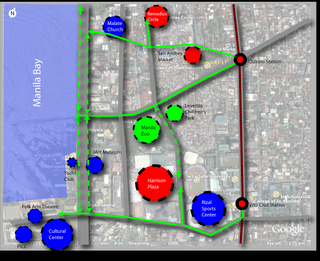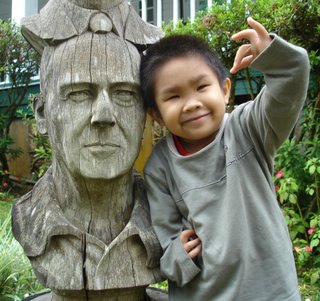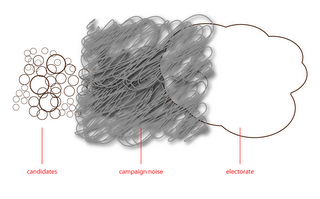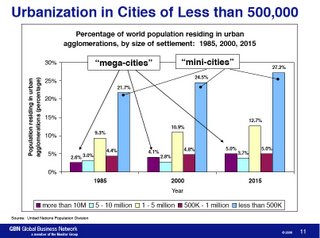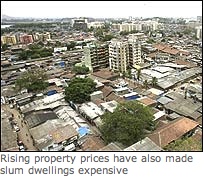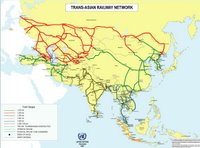After seven days, the Save Jack Simbulan fundable.org campaign has hit the $900 mark, just a hundred shy of 20%. We have 14 days left to complete the target and need 164 more people to pledge at least $25 each. Remember that if we DON'T hit the target amount ($5,000) in pledges, then no money will be collected.
Our sincerest thanks to the following: Georgia, Jenny, Aimee, Mai, Therese, Candice and Tim*, Malyn, Mel and Paul, Joselito*, Essa and Frederik, Rajendra, Cecille*, Reine and Andrea, Michelle, Alice, Cathy and Manuel, Anna, Amanda, and Elizabeth and Ryan. Special thanks to Mai and Aimee and Raymond V. who helped to spread the word. Also special thanks to Amalah, for posting about Jack.
If would like to help out, the fund takes pledges via paypal or credit card. You could also help out by either posting a link to this post, or Jack's blog or sending email to your friends about Jack. You could also choose to help Jack through the fundraising campaign led by Babette's (Jack's mom) friends the Ateneo Student Catholic Action (AtSCA Batch 94, Cell 3 and Cell 6). Details via the savejacksimbulan.org website.
And for the doubters, I am reproducing my wife's blog post from a few days ago (after the jump).
If you would like to confirm Jack with a real live person, contact Jack's grandmother (in the US) or his parents (in the Philippines).
(BTW, i know there are a lot of good causes apart from Jack. Please also help Naga City recover from Typhoon Reming.)
(*-joselito, candice, cecille -fundable.org lists double pledges from each of you, did you mean to pledge twice or did you accidentally click twice? Please email me at urbanodelacruz_at_gmail_dot_com if it was an error and I can delete the redundant pledge.)
Jack and Fanconi Anemia 101

As mentioned in the last post, I realized that a lot of folks might be unable to go through Jack's whole blog and other sites that explain his disease, Fanconi Anemia, so I'm going to do my best to distill what I know about Jack and FA.
First of all, Jack really and truly does exist. Benjie worked with his mom, Babette, back in Manila from '97 to '99. We attended her wedding to Juni. (I feel I have to write this just in case some readers have been victimized too often by internet scams.)
Secondly, Jack really and truly does have Fanconi Anemia. It's an inherited disease--sort of like hemophilia in pattern (a child of two parents with mutations in the same genes for FA has a 25% chance of being born with the condition). It's a disease that can and usually does lead to leukemia, and older patients tend to have a very high (relative to the general population) rate of carcinomas in the head, neck, gastrointestinal and gynecological areas.
Third, Jack's been diagnosed with first-stage bone marrow failure--his bone marrow is starting to fail at its job which is to produce enough red blood cells(to carry oxygen), white blood cells (to fight infection) and platelets (to help the blood clot). Hence, the need for Babette & Juni to constantly monitor Jack for symptoms indicating a low count of any of these cells, many more blood tests on Jack than you'd need in a healthy lifetime, and transfusions when any counts are low.
Jack needs a bone marrow transplant.
Jack has been subjected to many blood transfusions already this year, and I can only imagine how painful it is for him and his parents every time he needs one, and how each day they wake up hoping that Jack won't need another trip to the hospital. If you read his blog, though, you'll maybe laugh (as I do) when I read about Jack's jokes, wisecracks, and arguments--this boy is spirited, intelligent, funny, so full of character.
(There are risks to the bone-marrow transplant too, but right now it's their best hope. Jack can't just keep getting transfusions indefinitely every time his platelets go down--he increases his risk for infection and for rejecting the transplant later on.)
Fourth, Jack needs to have his bone marrow transplant elsewhere.
The hospitals back in the Philippines don't have the capacity to deal with the procedure. Juni and Babette have been told that their best bets are hospitals in Cincinatti and Manhattan in the US. For this, they have to raise a LOT of money.
(On the bright side, there are three potential matches in the US national bone marrow registry!)
Fifth, Jack needs $350,000.
Juni and Babette, by Filipino standards, are well-off. They are both college-educated, have white collar jobs, own their own home (though still paying the mortgage). In contrast, most Filipinos struggle to put meals on the table, can't afford the down payment for their own homes, consider a visit to McDonald's a luxury.
But there's no way Babette & Juni can produce $350,000 on their own to pay for Jack's bone marrow transplant. (That's the cost of the procedure alone, not including flights, accommodations, meals, etc.) They can probably save and borrow to cover the latter costs, but they need all the help they can get to raise the $350,000 for the transplant. (Most Filipinos will not earn the equivalent of $350,000 in their lifetimes.)
(Health insurance barely exists back in the Philippines. Babette and Juni get some through work but what they have doesn't cover their current medical expenses like transfusions and tests, much less a procedure like the BMT.)
We are all hopeful that help will come in other ways--one of Amalah's readers pointed out St. Jude's in Tennessee, which at this point I'm very hopeful about. But until and unless Babette and Juni hear for sure that St. Jude's or a similar facility can arrange the procedure at little or no cost, we have to proceed as if we have to raise the entire $350,000 ourselves.
Sixth, Jack needs your help. NOW.
Prayers are good. (I believe in the power of prayer--to heal those who are sick AND to sustain those caring for the sick.)
Donations to Jack's fundable account are great (it runs till Christmas day!).
If you feel you can't make a donation, I respect that. I understand people have different priorities, and their own crises to worry over. But do think about it. If you can't donate, maybe you send family and friends toward this blog, or Jack's? Or the fund?
Lastly, and I hate to "play" this card: but try to put yourself in Juni & Babette's shoes.
Imagine having a child with a serious, life-threatening disease that's mostly unheard of where you live.
Imagine not having health insurance, and living in a country that's medically a few steps behind the first world when it comes to rare cases like FA.
Imagine how unreachable $350,000 seems when you earn maybe $25000 or $30000 a year before taxes.
Imagine getting up every day hoping your child will get through it without getting sick or needing a transfusion.
Thanks for reading. Peace and blessings to you!
 (Full disclosure, I used to work for Ayala Corporation.)
(Full disclosure, I used to work for Ayala Corporation.)







